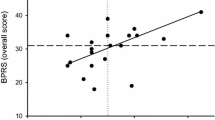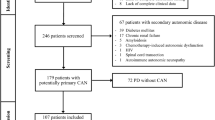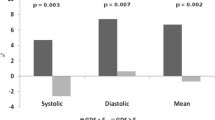Abstract
Nocturnal blood pressure (BP) changes are an indicator of autonomic dysfunction. We aim to investigate the correlation between nocturnal blood pressure (BP) variability, vitamin D levels and Parkinson’s disease severity (PD) in this study. Thirty-five patients with PD participated in the study. Disease severity was evaluated by United Parkinson’s Disease Rating Scale (UPDRS) and Hoehn and Yahr Scale (HYS). Equivalent levodopa dose was calculated and 25-hydroxyvitamin D levels were measured. The Non-Motor Symptom Questionnaire (NMSQ) was applied to all patients. Ambulatory BP monitoring for 24 h was established. Patients were divided into three groups according to nocturnal BP results: dippers (normal finding—a decline in mean nighttime BP of more than 10%); non-dippers (pathological—a decline in mean nighttime BP of less than 10%); reverse dippers (pathological—an increase in mean nighttime BP) .The mean score of the NMSQ was higher in the group with HYS > 2 (p = 0.050). Four patients were dipper, 17 patients were non-dipper and 16 patients were reverse dipper. There was no significant difference between the three groups in terms of age, gender, disease duration, age of the disease onset, disease stage, disease duration, dopamine agonist usage, levodopa equivalent dose, vitamin D level and NMSQ scores. NMSQ scores are high in advanced PD. Ambulatory BP monitoring is useful in detecting autonomic dysfunction. The number of patients with non-dipping and reverse dipping is high in PD, independent from PD severity, drug dose, vitamin D and the other NMS symptoms.
Similar content being viewed by others
References
Antonini A, Barone P, Marconi R, Morgante L, Zapulla S, Pontieri FE, Ramat S, Ceravolo MG, Meco G, Cicarelli G, Pederzoli M, Manfredi M, Ceravolo R, Mucchiut M, Volpe G, Abbruzzese G, Bottacchi E, Bartolomei L, Ciacci G, Cannas A, Randisi MG, Petrone A, Baratti M, Toni V, Cossu G, Del Dotto P, Bentivoglio AR, Abrignani M, Scala R, Pennisi F, Quatrale R, Gaglio RM, Nicoletti A, Perini M, Avarello T, Pisani A, Scaglioni A, Martinelli PE, Iemolo F, Ferigo L, Simone P, Soliveri P, Troianiello B, Consoli D, Mauro A, Lopiano L, Nastasi G, Colosimo C (2012) The progression of non-motor symptoms in Parkinson’s disease and their contribution to motor disability and quality of lif. J Neurol 259:2621–2631
Ha AD, Brown CH, York MK, Jankovic J (2011) The prevalence of symptomatic orthostatic hypotension in patients with Parkinson’s disease and atypical parkinsonism. Parkinsonism Relat Disord 17(8):625–628. https://doi.org/10.1016/j.parkreldis.2011.05.02
O’Brien E, Sheridan J, Malley OK (1998) Dippers and non-dippers. Lancet 12:397
Di Daniele N, Fegatelli DA, Rovella V, Castagnola V, Gabriele M, Scuteri A (2017) Circadian blood pressure patterns and blood pressure control in patients with chronic kidney disease. Atherosclerosis 267:139–145
Ejaz AA, Sekhon IS, Munjal S (2006) Characteristics findings ies of patients with Parkinson’s disease. Er J Intern Med 17:417–420
Schmidt C, Berg D, Prieur S. Et al. Schmidt C, Berg D, Herting, Prieur S, Junghanns S, Schweitzer K, Globas C, Schöls L, Reichmann H, Ziemssen T (2009) Loss of nocturnal blood pressure fall in various extrapyramidal syndromes. Mov Disord 24:2136–2142
Senard JM, Chamontin B, Rascol A, Montastruc JL (1992) Neurogenic orthostatic hypotension as the initial feature of Parkinson disease. Clin Auton Res 2:99–104
Linden D, Diehl RR, Berlit P (1997) Sympathetic cardiovascular dysfunction in longstanding idiopathic Parkinson’s disease. Clin Auton Res 7:311–314
Goldstein DS (2006) Orthostatic hypotension as an early finding in Parkinson disease. Clin Auton Res 16:46–54
Milazzo V, Di Stefano C, Servo S, Zibetti M, Lopiano L, Maule S (2012) Neurogenic orthostatic hypotension as the initial feature of Parkinson disease. Clin Auton Res 22:203–206
Kalueff AV, Eremin KO, Tuohımaa P (2004) Mechanisms of neuropretective action of vitamin D3. Biochemistry 69:738–741
Jang W, Park J, Kim JS, Youn J, Oh E, Kwon KY, Jo KD, Lee MK, Kim H-T (2015) Vitamin D deficiency in Parkinson’s disease patients with orthostatic hypotension. Acta Neurol Scand 132:242–250
Pilz S, Tomaschitz A, Ritz E, Pieber TR (2009) Vitamin D status and arteriel hypertension: a systematic review. Nat rev Cardiol 6:621–630
Vinh Quoc Luong K, Thi Hoang Nguyen L (2012) Vitamin D and Parkinson’s disease. J Neurosci Res 90:2227–2236
Hughes AJ, Daniel SE, Kilford L, Lees AJ (1992) Accuracy of clinical diagnosis of idiopathic Parkinson’s disease: a clinico-pathological study of 100 cases. J Neurol Neurosurg Psychiatry 55:181–184
Tomlinson CL, Stowe R, Patel S, Rick C, Gray R, Clarke CE (2010) Systematic Review of Levodopa Dose Equivalency Reporting in Parkinson’s. Disease Mov Disord 25:2649–2653
Eigenbrodt ML, Rose KM, Couper DJ, Arnett DK, Smith R, Jones D (2000) Orthostatic hypotension as a risk factor for stroke: the atherosclerosis risk in communities (ARIC) study, 1987–1996. Stroke 31:2307–2313
Schapira AH (2013) Recent developments in biomarkers in Parkinson disease. Curr Opin Neurol 26:395–400
Chaudhuri KR, Healy DG, Schapira AH, National Institute for Clinical Excellence (2006) Non-motor symptoms of Parkinson’s disease: diagnosis andmanagement. Lancet Neurol 5:235–245
Barone P, Antonini A, Colosimo C, Marconi R, Morgante L, Avarello TP, Bottacchi E, Cannas A, Ceravolo G, Ceravolo R, Cicarelli G, Gaglio RM, Giglia RM, Iemolo F, Manfredi M, Meco G, Nicoletti A, Pederzoli M, Petrone A, Pisani A, Pontieri FE, Quatrale R, Ramat S, Scala R, Volpe G, Zappulla S, Bentivoglio AR, Stocchi F, Trianni G, Dotto PD, PRIAMO study group (2009) The PRIAMO study: a multicenter assessment of nonmotor symptoms and their impact on quality of life in Parkinson’s disease. Mov Disord 24:1641–1649
Crosiers D, Pickut B, Theuns J, Deyn PP, Van Broeckhoven C, Martinez-Martin P, Chaudhuri KR, Cras P (2012) Non-motor symptoms in a Flanders-Belgian population of 215 Parkinson’s disease patients as assessed by the Non-motor Symptoms Questionnaire. Am J Neurodegener Dis 1:160–167
Gan J, Zhou M, Chen W, Liu Z (2014) Non-motor symptoms in Parkinson’s disease patients. J Clin Neurosci 21:751–754
Hermida RC (2007) Ambulatory blood pressure monitoring in the prediction of cardiovascular events and effects of chronotherapy: rationale and design of the MAPEC study. Chronobiol Int 24:749–775
Saladini F, Di Marco A, Palatini P (2016) Autonomic dysfunction: how to identify and when to treat? High Blood Press Cardiovasc Prev 23:237–243
Park JH, Lee HS, Kim JH, Lee JH, Kim J, Choi SW (2014) J Stroke Cerebrovasc Dis 23:1171–1176
Yan B, Peng L, Dong Q, Zheng F, Yang P, Sun L, Gong S, Zeng L, Wang G (2015) Reverse-dipper pattern of blood pressure may predict lacunar infarction in patients with essential hypertension. Reverse-dipper pattern of blood pressure may predict lacunar infarction in patients with essential hypertension. Eur J Neurol 22:1022–1025
Wang C, Ye Z, Li Y, Zhang J, Zhang Q, Ma X, Peng H, Lou T (2016) Prognostic value of reverse dipper blood pressure pattern in chronic kidney disease patients not undergoing dialysis: prospective cohort study. Sci Rep 6:34932
Sommer S, Aral-Becher B, Jost W (2011) Nondipping in Parkinson’s disease. Parkinsons Dis 2011:897586
Oh YS, Kim JS, Chung YA, You IeR, Yang DW, Chung SW, Park JW, Kim YI, Lee KS (2013) Orthostatic hypotension, non-dipping and striatal dopamine in Parkinson disease. Neurol Sci 34:557–560
Milazzo V, Di Stefano C, Vallelonga F, Sobrero G, Zibetti M, Romagnolo A, Merola A, Milan A, Espay AJ, Lopiano L, Veglio F, Maule S (2018) Reverse blood pressure dipping as marker of dysautonomia in Parkinson disease. Parkinsonism Relat Disord
Noack C, Schroeder C, Heusser K, Lipp A (2014) Cardiovascular effects of levodopa in Parkinson’s disease. Parkinsonism Relat Disord 20:815–818
Mehagnoul-Schipper DJ, Boerman RH, Hoefnagels WH, Jansen RW (2001) Effect of levodopa on orthostatic and postprandial hypotension in elderly Parkinsonian patients. J Gerontol A Biol Sci Med Sci 56:M749–M755
Goldstein DS, Eldadah BA, Holmes C, Pechnik S, Moak J, Saleem A, Sharabi Y (2005) Neurocirculatory abnormalities in Parkinson disease with orthostatic hypotension: independence from levodopa treatment. Hypertension 46:1333–1339
Kujawa K, Leurgans S, Raman R, Blasucci L, Goetz CG (2000) Acute orthostatic hypotension when starting dopamine agonists in Parkinson’s disease. Arch Neurol 57:1461–1463
Sánchez-Ferro A, Benito-León J, Gómez-Esteban JC (2013) The management of orthostatic hypotension in Parkinson’s disease. Front Neurol 4:64
Resta O, Rana L, Procacci V, Guido P, Picca V, Scarpelli F (1998) Autonomic dysfunction in normotensive awake subjects with obstructive sleep apnoea syndrome. Monaldi Arch Chest Dis 53(1):23–29
Cortelli P, Parchi P, Sforza E, Contin M, Pierangeli G, Barletta G, Lugaresi E (1994) Cardiovascular autonomic dysfunction in normotensive awake subjectswith obstructive sleep apnoea syndrome. Clin Auton Res 4(1–2):57–62
Jain S, Goldstein DS (2012) Cardiovascular dysautonomia in Parkinson disease: from pathophysiology to pathogenesis. Neurobiol Dis 46:572–580
Jang W, Park HH, Lee KY, Lee YJ, Kim HT, Koh SH (2015) 1,25-dyhydroxyvitamin D3 attenuates L-DOPA-induced neurotoxicity in neural stem cells. Mol Neurobiol 51:558–570
Evatt ML, DeLong MR, Kumari M, Auinger P, McDermott MP, Tangpricha V (2011) High prevalence of hypovitaminosis D status in patients with early Parkinson disease. Arch Neurol 68:314–319
Ding H, Dhima K, Lockhart KC, Locascio JJ, Hoesing AN, Duong K, Trisini-Lipsanopoulos A, Hayes MT, Sohur US, Wills AM, Mollenhauer B, Flaherty AW, Hung AY, Mejia N, Khurana V, Gomperts SN, Selkoe DJ, Schwarzschild MA, Schlossmacher MG, Hyman BT, Sudarsky LR, Growdon JH, Scherzer CR (2013) Unrecognized vitamin D3 deficiency is common in Parkinson disease: Harvard Biomarker Study. Neurology 81:1531–1537
Newmark HL, Newmark J (2007) Vitamin D and Parkinson’s disease-a hypothesis. Mov Disord 22:461–468
Petersen MS, Bech S, Christiansen DH, Schmedes AV, Halling J (2014) The role of vitamin D levels and vitamin D receptor polymorphism on Parkinson’s disease in the Faroe Islands. Neurosci Lett 561:74–79
Suzuki M, Yoshioka M, Hashimoto M, Murakami M, Noya M, Takahashi D, Urashima M (2013) Randomized, double-blind, placebo-controlled trial of vitamin D supplementation in Parkinson disease. Am J Clin Nutr 97:1004–1013
Kunutsor SK, Apekey TA, Steur M (2013) Vitamin D and risk of future hypertension: meta-analysis of 283,537 participants. Eur J Epidemiol 28:205–221
Pekkanen MP, Ukkola O, Hedberg P, Piira OP, Lepojärvi S, Lumme J, Tulppo MP, Huikuri HV (2015) Serum 25-hydroxyvitamin D is associated with major cardiovascular risk factors and cardiac structure and function in patients with coronary artery disease. Nutr Metab Cardiovasc Dis 25:471–478
Author information
Authors and Affiliations
Corresponding author
Ethics declarations
Conflict of interest
The authors declare that there is no conflict of interest.
Additional information
Publisher’s Note
Springer Nature remains neutral with regard to jurisdictional claims in published maps and institutional affiliations.
Rights and permissions
About this article
Cite this article
Arici Duz, O., Helvaci Yilmaz, N. Nocturnal blood pressure changes in Parkinson’s disease: correlation with autonomic dysfunction and vitamin D levels. Acta Neurol Belg 120, 915–920 (2020). https://doi.org/10.1007/s13760-019-01113-7
Received:
Accepted:
Published:
Issue Date:
DOI: https://doi.org/10.1007/s13760-019-01113-7




